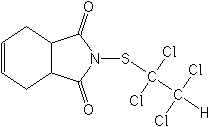-
Common NameCaptafol
-
中文通用名敌菌丹
-
IUPACN-(1,1,2,2-tetrachloroethylthio)cyclohex-4-ene-1,2-dicarboximide
or
3a,4,7,7a-tetrahydro-N-(1,1,2,2-tetrachloroethanesulfenyl)phthalimide -
CAS3a,4,7,7a-tetrahydro-2-[(1,1,2,2-tetrachloroethyl)thio]-1H-isoindole-1,3(2H)-dione
-
CAS No.2425-06-1
-
Molecular FormulaC10H9Cl4NO2S
-
Molecular Structure
-
Physical PropertiesMolecular weight:349.1; Physical form:Colourless to pale yellow crystals; (tech. is a light tan powder, with a characteristic odour). Composition:Tech. is × 95%. Melting point:160-161 °C; Vapour pressure: Negligible at room temperature; Partition coefficient(n-octanol and water):logP = 3.8; Solubility:In water 1.4 mg/l (20 °C). Slightly soluble in most organic solvents. In isopropanol 13, benzene 25, toluene 17, xylene 100, acetone 43, methyl ethyl ketone 44, dimethyl sulfoxide 170 (all in g/kg).; Stability:Slowly hydrolysed in aqueous emulsion or suspension. Rapidly hydrolysed in acidic and alkaline media. Decomposes slowly at the melting point. Only slightly soluble in organic solvents.
-
ToxicologyOral:Acute oral LD50 for rats 5000-6200 mg/kg. Percutaneous:Acute percutaneous LD50 for rabbits >15 400 mg/kg. Corrosive to eyes; mild skin irritant (rabbits). May cause allergic skin reactions in some people. Inhalation:
50 for male rats >0.72, female rats 0.87 mg/l (tech.). Dust may cause respiratory irritation. Phytotoxicity:Under certain conditions, grapes, apples, citrus fruit and roses may be injured. -
Environmental ProfileEcotoxicology: Bees:Not toxic to bees.Birds:Dietary LC50 (10 d) for pheasants >23 070, mallard ducks >101 700 mg/kg diet.Daphnia:LC50 (96 h) 3.34 ppm.Fish:LC50(96 h) for rainbow trout 0.5, goldfish 3.0 mg/l , bluegill sunfish 0.15 mg/l.Other aquatic spp.:Moderately to very highly toxic to freshwater invertebrates. Environmental fate: Animals:In mammals, following oral administration, captafol is hydrolysed to tetrahydrophthalimide (THPI) and dichloroacetic acid. THPI is degraded to tetrahydrophthalimidic acid and further to phthalic acid and ammonia.Plant:In plants, metabolism is the same as in animals.
WATER SOLUBILITY: Practically insoluble -
Transport InformationSignal Word:CAUTION; Hazard Class:Ia (Extremely hazardous)
Porduct NewsMore
Orthosulfamuron boosts sugarcane production, study finds
Glyphosate price plummets 40% in one year in Argentina
Indian govt stops imports of herbicide Glufosinate priced below Rs 1,289 per kg
Carbendazim fungicide wins victory in Brazilian Parliament
Corteva presents new pre-emergent herbicide Linear for sugarcane in Brazil
Picloram Triclopyr Aminopyralid
Revolutionizing disease prevention: BASF launches new rice fungicide Cevya® in China
Thiamethoxam is allowed again in Brazil by a judicial decision
Bayer develops alternative to glyphosate herbicide

 0
0 Subscribe
Subscribe
